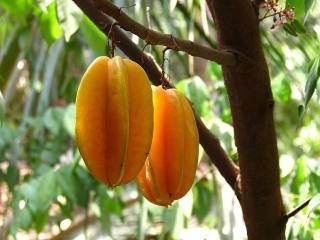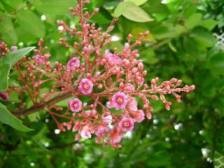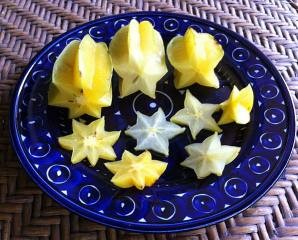Carambola
 Common Name: Carambola, star fruit
Common Name: Carambola, star fruit
Scientific Name: Averrhoa carambola
Climate: Temperate and warm
Plant Description: Plant Description: It is a perennial tropical shrub from three to five meters tall. The leaves are distributed along the branches, and are 8-18 cm in length. It has short inflorescences (a set of flowers that grow along a stem) that are axillary or can grow in the place occupied by the previous leaves, on a 1 cm long stem. Its fruit (star fruit) appears in clusters on the branches and on the trunk: these are thick fleshy berries; elongated, oval, with a star shape of five angles. When they mature they are yellow-orange in color. Its surface is waxy. When we make a cross section we can see its star shape. Its pulp is light yellow, translucent, juicy, without fiber. It can be sweet or acidic.
Its origin is tropical Southeast Asia. The main producers are Thailand, Sri Lanka, India, Brazil.
Cultivation: It needs to be planted in full sun. It does not grow where there is frost. It thrives in sandy or clay soils, tolerates limestone soils that have good drainage. Flooding and waterlogging can cause plant root rot. It does not tolerate drought conditions nor salt in the ground.
It can be propagated by seeds, which must be selected from healthy trees, with good production and quality of fruit. The seeds must be separated quickly to avoid loss of viability, and dried in the shade but not in low temperature shade. Sow the seeds at 1cm depth. Planting distance: 6 x 6m. or 7 x 5 m. between rows and plants in warm, moist soil - not wet.1
 Maintain heat and humidity conditions. Sprouts will develop between two to three weeks.
Maintain heat and humidity conditions. Sprouts will develop between two to three weeks.
It can also be propagated by grafting. The best results are obtained from lateral and leaflet grafts during the time when growth is most active. Healthy little trees growing fast and are 7mm in diameter are best for rootstocks. It’s recommended that the rootstock be at least one year old. Cuttings should be taken from mature twigs on which there are still leaves and when the shoots are just beginning to grow.2 Or, cuttings can be prepared 3 to 4 days before grafting, removing all the leaves. This will stimulate the growth of the buds.
The plant begins to bear fruit after 3 years. The fruits are harvested manually, preferably ripe yellow, since in post-harvest they have a much slower process to reach color.
It needs regular watering, although it has temporary tolerance in dry areas. Fertilize regularly.
 Uses: The fruit contains fiber, which has softening and laxative properties for the intestinal tract. Its consumption can lower cholesterol in the body. It helps people with diabetes, high blood pressure and conditions of both blood vessels and the heart.
Uses: The fruit contains fiber, which has softening and laxative properties for the intestinal tract. Its consumption can lower cholesterol in the body. It helps people with diabetes, high blood pressure and conditions of both blood vessels and the heart.
Pests and Diseases: The main pest is the fruit fly and is being detected by appearance of brown spots throughout the fruit. Mites, scale and caterpillars feed on the tree's foliage, and the other pests attack its ripening fruit.
Fungal diseases such as anthracnose, black mold or leaf spot develop on stressed and poorly maintained trees. Proper care and maintenance of the tree is the best preventive measure. Treat a pest infested star fruit tree with a combination of horticultural oils, insecticidal soaps, and predatory insects. Spraying the tree with natural fungicides early in the season can prevent the development of the disease.
References:
- http://articulos.infojardin.com/Frutales/fichas/carambola-carambolos-tamarindo-chino-averrhoa-carambola.htm
- http://usi.earth.ac.cr/glas/sp/Carambola.pdf
En español: Carambola
